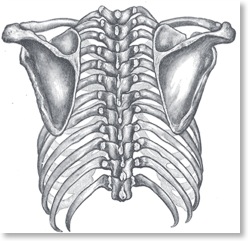 The shoulder girdle is made of four bones, two shoulder blades, or scapulae, and two clavicles, or collar bones. The shoulder girdle hovers above the rib cage and the shoulder blades should be even across the back with the top of the inner or medial part of the blades parallel to each other and equidistant from the spine. The shoulder blades are meant to be anchored on the back of the rib cage by a large group of muscles even though they don’t actually touch the ribs. They are connected to the arm, ribs, and spine by these muscles all pulling in different directions.
The shoulder girdle is made of four bones, two shoulder blades, or scapulae, and two clavicles, or collar bones. The shoulder girdle hovers above the rib cage and the shoulder blades should be even across the back with the top of the inner or medial part of the blades parallel to each other and equidistant from the spine. The shoulder blades are meant to be anchored on the back of the rib cage by a large group of muscles even though they don’t actually touch the ribs. They are connected to the arm, ribs, and spine by these muscles all pulling in different directions.
If I stand behind you it shouldn’t be easy to take your shoulder blade into my hand. It would mean that I could wrap my thumb around and behind the inner spine and my other fingers around and behind the outside of the shoulder blade. To me this indicates poor tone in at least some of the muscles listed below. The shoulder blades should be firm on the back providing some resistance to prying fingers.
Here is a list of the muscles connecting the shoulder blade to the rest of the body (and I might have missed one or two). It really is an amazing body that we inhabit:
- Pectoralis minor
- Pectoralis major
- Trapezius
- Serratus anterior
- Rhomboid major and minor
- Teres major
- The rotator cuff muscles (supraspinatus, infraspinatus, subscapularis, teres minor)
- Levator scapula
- Omohyoid
- Biceps, triceps, deltoids…
- ..and a bit of the latissimus dorsi
If all of these muscles pulling in different directions do their jobs, the shoulder blade doesn’t move much, basically shimmying around in place because all of these muscles are engaging and working as designed. The stability of the shoulder blades on the back of the rib cage determine a great deal of what yoga students can do in weight bearing poses like planks and arm balances. The scapula I can take in my hand easily is not going to stabilize well on the back and will not being able to accomplish more advanced poses.
The image of solid shoulder blades on the back is represented by someone who can maintain the same alignment of the chest while standing and while moving through poses that bear weight on the arms. If the alignment of the upper back and upper chest always remain the same the shoulders are being kept successfully on the back.
Lowering from plank pose to chaturanga dandasana is a good example to look at. Someone’s shoulders are on the back successfully if their upper chest and the upper back remain exactly the same in the transition from plank to chaturanga. In this movement all of the muscles that connect to and surround the shoulder blade are called into action and the result is a stable balance that maintains the position of the shoulder blade as the body lowers down.
The opposite scenario would be shoulder blades that move too much in one direction instead of hovering in place above the rib cage. Examples of this are the head of the arm bone diving forward once it reaches the height of the elbow or the shoulder blades moving towards each other too much.
When you see a yoga student who can do advanced inversions with variations like lotus or backbends, it is most often the stability of the shoulder blades on the back that allow them to move so deeply.
***
